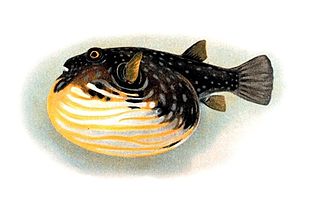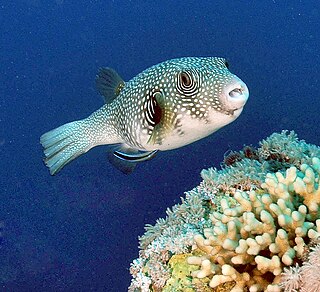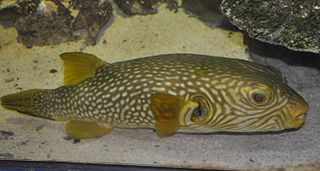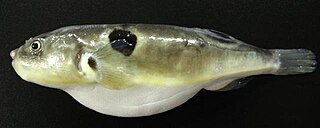
Tetraodontidae is a family of primarily marine and estuarine fish of the order Tetraodontiformes. The family includes many familiar species variously called pufferfish, puffers, balloonfish, blowfish, blowies, bubblefish, globefish, swellfish, toadfish, toadies, honey toads, sugar toads, and sea squab. They are morphologically similar to the closely related porcupinefish, which have large external spines. The scientific name refers to the four large teeth, fused into an upper and lower plate, which are used for crushing the hard shells of crustaceans and mollusks, their natural prey.

Arothron is a genus in the pufferfish family Tetraodontidae found in warm parts of the Atlantic, Indian and Pacific Ocean. These species are sometimes kept in aquaria. The largest species is A. stellatus, which can reach 1.2 m (3.9 ft) in length.

The white-spotted puffer is a medium to large-sized puffer fish, it can reach 50 cm length. It is light grey in color, or greyish or yellowish, and clearly covered with more or less regular white points, that become concentric contrasting white and dark grey lines that radiate around the eyes and pectoral fins. The ventral part is white. The "shoulder" is dark. It also has concentric contrasting white and dark grey lines that radiate around the eyes and pectoral fins.

The clearfin lionfish, also called the tailbar lionfish, radiata lionfish, fireworks fish or radial firefish, is a carnivorous, ray-finned fish with venomous spines that lives in the Indian and western Pacific Oceans. This is the only lionfish species which has spines without any markings. It can also be recognized by the pair of horizontal white stripes on its caudal peduncle.

The narrow-lined pufferfish is a demersal marine fish belonging to the family Tetraodontidae.

The starry toado is a pufferfish of the family Tetraodontidae, found in subtropical oceans worldwide, at depths between 10 and 360 m. Its length is up to 40 cm.

The blackspotted puffer, also known as the dog-faced puffer, is a tropical marine fish belonging to the family Tetraodontidae.

The map puffer, also known as the map pufferfish, scribbled pufferfish, or Kesho-fugu, is a demersal marine fish belonging to the family Tetraodontidae. The map puffer is typically found in tropical and subtropical waters from the Indian Ocean to the western Pacific Ocean. This fish contains tetrodotoxin, a potent and deadly chemical compound used to ward off predators. Despite being highly poisonous, the map puffer can be found both in the aquarium trade and certain food markets.

The masked puffer is a pufferfish in the family Tetraodontidae.

Cephalopholis spiloparaea, known commonly as the strawberry hindstrawberry rock cod, strawberry cod or orange rock cod, is a species of marine ray-finned fish, a grouper from the subfamily Epinephelinae which is in the family Serranidae which also includes the anthias and sea basses. This fish occurs throughout the Indo-Pacific region.

Arothron meleagris, commonly known as the guineafowl puffer or golden puffer, is a pufferfish from the Indo-Pacific, and Eastern Pacific. It is occasionally harvested for the aquarium trade. It reaches 50 cm in length.

Arothron immaculatus, the immaculate puffer or yellow-eyed puffer, is a pale greyish to brownish pufferfish from the Indo-West Pacific. It is a species of marine fish in the family Tetraodontidae.

Arothron stellatus, also known as the stellate puffer, starry puffer, starry pufferfish, or starry toadfish, is a demersal marine fish belonging to the family Tetraodontidae. It is found in shallow water in the Indo-Pacific region.

Arothron caeruleopunctatus, also known as the blue-spotted pufferfish, is a demersal marine fish belonging to the family Tetraodontidae.

Arothron reticularis, variously known as the reticulated pufferfish, reticulated blowfish or reticulated toadfish, is a ray-finned fish in the family Tetraodontidae. It is native to the tropical and sub-tropical Indo-Pacific region where its habitats include sandy and muddy seabeds, coral reefs, estuaries and mangrove areas.
Arothron carduus is a ray-finned fish in the family Tetraodontidae. It is an uncommon species and is native to the tropical and sub-tropical Indo-Pacific region.

The white-spotted pufferfish is known for its unique and complex courtship display which involves creating large, geometric circles in the sand. These circles are constructed in an effort to attract females for copulation. Males must maintain their circles in order to attract a mate. A female will evaluate the structure and choose to mate with the males after evaluation and completion of other mating behaviors.

Takifugu obscurus or the obscure pufferfish is a species of euryhaline, anadromous pufferfish first described by T. Abe in 1949. It has been categorized by the IUCN as a least-concern species globally since 2014; in South Korea, it is however classified as an endangered species due to overfishing of its endemic populations. The Catalogue of Life lists no subspecies of Takifugu obscurus. The species prefers deeper, clearer areas of brackish and fresh water, and is found estuaries, as well as rivers and tributaries thereof such as the South Korean rivers Geum, Han, and Imjin, or the Tamsui River in mainland China. The species is endemic to North and South Korea, the Sea of Japan, and the East and South China Seas. Uses of Takifugu obscurus include human consumption, use in animal testing, and owning specimens as pets. As with most species of pufferfish, several organs of Takifugu obscurus contain tetrodotoxin, making it potentially poisonous if not prepared safely by trained persons.
Canthigaster aziz, known as Aziz's toby, is a species of pufferfish in the family Tetraodontidae. It was described in 2020 by Keiichi Matsuura, Sergey V. Bogorodsky, Ahmad O. Mal, and Tilman J. Alpermann based on a single specimen collected from the northern Red Sea off of Saudi Arabia. It was trawled from a depth of 315 m, which is reportedly the second highest depth at which any fish of the genus Canthigaster has been collected. The only known specimen measures 2 cm SL. The species was named after the King Abdulaziz University. It is thought to have been collected over a hard substrate as the trawling gear used to collect it was severely damaged during operation.















